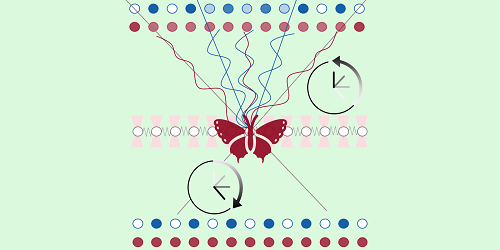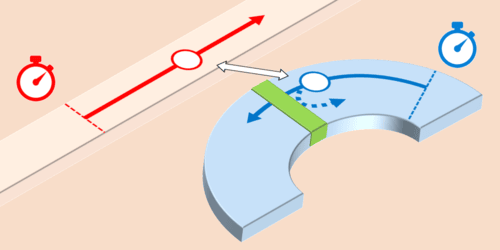August 7, 2025• Physics 18, s98
An electron on a ballistic trajectory can be detected with trillionth-of-a-second timing resolution through its long-range interaction with another electron.
J. D. Fletcher et al. [1]

J. D. Fletcher et al. [1]
The ability to sense individual ballistic electrons, which move through a material without scattering, is useful for certain applications in quantum metrology, quantum information processing, and the emerging field of electron quantum optics. But the timing resolution of current sensing techniques can often be inadequate, typically being limited to the nanosecond-to-microsecond range. Now a way to detect single ballistic electrons with picosecond resolution has been experimentally demonstrated by researchers in the UK and South Korea [1]. The approach also provides a flexible platform for studying the interactions between individual electrons.
The researchers’ strategy is based on a scheme in which two ballistic electrons—a “sensing” electron and a “detected” electron—travel toward each other along separate, nearby paths. If the electrons are in close proximity when the sensing electron reaches a certain position in its path, the sensing electron will be deflected by its long-range electrostatic interaction with the detected electron. Otherwise, there will be no such deflection. By varying the times at which the two electrons are injected into their respective paths and observing when this deflection occurs, experimenters can obtain a time-resolved measurement of the detected electron.
The researchers implemented this scheme using two ballistic electrons fired from separate on-demand sources and moving within a 2D electron gas. They found that they could sense the detected electron in this setup with a timing resolution of about 6 picoseconds. Additionally, by varying both the energies and injection times of the electrons, they showed how their setup could be used to observe electron interactions with a wide range of strengths.
–Ryan Wilkinson
Ryan Wilkinson is a Corresponding Editor for Physics Magazine based in Durham, UK.
References
- J. D. Fletcher et al., “Coulomb sensing of single ballistic electrons,” Phys. Rev. Lett. 135, 067002 (2025).
Coulomb Sensing of Single Ballistic Electrons
J. D. Fletcher, W. Park, P. See, J. P. Griffiths, G. A. C. Jones, I. Farrer, D. A. Ritchie, H.-S. Sim, and M. Kataoka
Phys. Rev. Lett. 135, 067002 (2025)
Published August 7, 2025
Subject AreasCondensed Matter PhysicsQuantum PhysicsRelated Articles Quantum InformationBridging the Quantum Frequency GapAugust 6, 2025
Quantum InformationBridging the Quantum Frequency GapAugust 6, 2025
A new device can freely and efficiently change the frequency of microwave signals, enabling communication between otherwise incompatible quantum systems. Read More »

 Atomic and Molecular PhysicsQuantum Scrambling Goes AnomalousJuly 31, 2025
Atomic and Molecular PhysicsQuantum Scrambling Goes AnomalousJuly 31, 2025
Evidence that quantum information can get scrambled unconventionally in a chain of atoms could improve our understanding of quantum many-body dynamics. Read More »
